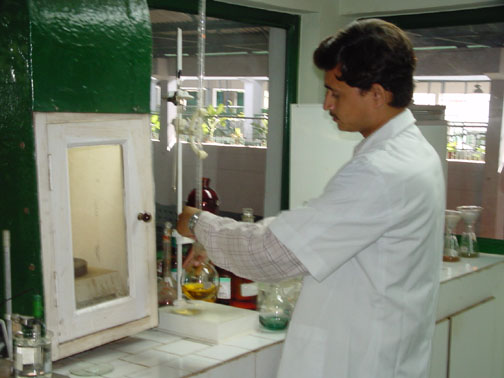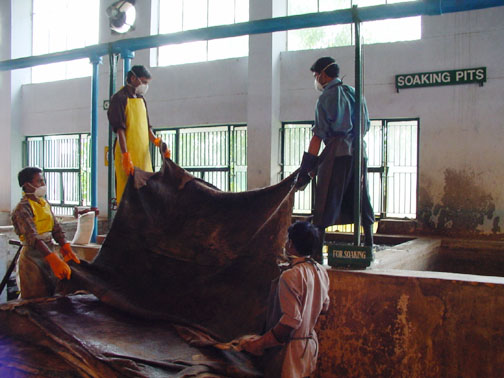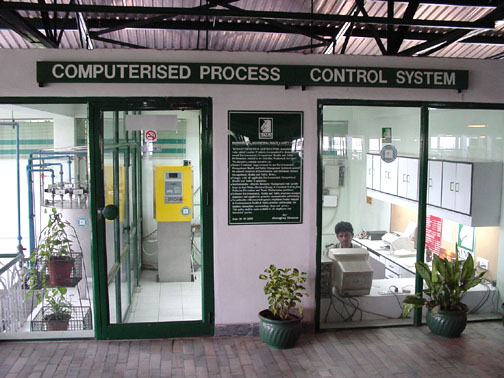In Uttar Pradesh, India, Solidaridad launched its first major programme for the leather sector in November: a five-year programme to promote sustainability in the leather cluster of Kanpur in India, on the borders of the Ganges river. In this project, we are working together with important local and international partners because we are confident that cooperation in the supply chain is crucial to promote sustainability. As our bottom-up strategy requires, all the important local and regional stakeholders have a place in this consortium. The next step is to also involve the key leather brands in the programme in order to cover the market perspective.

Inhouse process control
Social and environmental challenges
The leather sector, processing hides and skins into shoes, clothing, furniture, horse saddles and car seats among others, is huge. Every year, around 1.5 billion square meters of leather is produced worldwide with an estimated value of around € 40 billion. Leather processing is taking place in almost every country in the world with millions of people working in it. This comes with considerable social and environmental challenges in each step of the chain, from livestock farming, to slaughterhouses, tanneries and manufacturing.
Leather is the fifth largest commodity exported from India. The Kanpur Unnao leather cluster is globally recognized for saddlery, footwear and other leather products. With around 350 tanneries, it is an important industry in the state of Uttar Pradesh with 100,000 households depending on it for their income. But the tanneries are considered to be one of the leading industrial sectors causing pollution of the Ganga River Basin. And thousands of households downstream use the water for washing and irrigation.

Soaking of hides
A cleaner Ganges and improved livelihoods
One of the key purposes of the project in Kanpur is to contribute meaningfully in the National Mission for Clean Ganges of Government of India. Many of the important dignitaries from India and the Netherlands including the regulatory authorities participated in the event. The overall objective is to reduce the effluent water discharged by at least 40%. Together with chemical supplier STAHL, the Central Leather Research Institute, India and specialists of PUM Dutch senior experts, we will introduce alternative technologies and processes at tanneries to reduce environmental impacts from tanneries. We are also working with the communities downstream, who are affected by polluted water, on income generating activities and better use of water. We will focus on promoting continuous improvement, rather than certification, at tannery level and include as much tanneries in the transition as possible. An approach that can also provide learning experiences to apply in other regions.
Strong belief in cooperation
In the Kanpur leather programme, we brought together a large consortium with chemical supplier STAHL, PUM Dutch senior experts, the Uttar Pradesh Leather Industry Association (UPLIA), the Small Tanners Association (STA), the Central Leather Research Institute (CLRI) and the Ganga Pollution Control Unit of Uttar Pradesh Jal Nigam. We have chosen for a bottom-up approach with these partners, working together with the small-scale and large-scale tanners, the actors that actually need to make the change. We wish to continue our cooperation and extend our partnership in other leather clusters across India, Bangladesh and other potential leather producing locations around the globe.

Using modern technologies for the best production
The buyer is a crucial partner
I’m glad to see an expanding amount of initiatives in the global leather supply chain to improve sustainability. Pressured by NGOs and consumers, brands using leather are increasingly concerned about sustainability and mapping their supply chain. One strategy leather sourcing companies tend to follow is requiring certified leather production or just to outright refuse to buy from regions with a higher sustainability risk. Buying from the small group of tanners that are doing well may help to clean up the supply chain of buyers, but does little to improve the real problems. We want to call upon leather buying companies to step in, support programmes like our initiative and become part of the solution.
Learn more about Solidaridad sustainability programmes for livestock & leather
